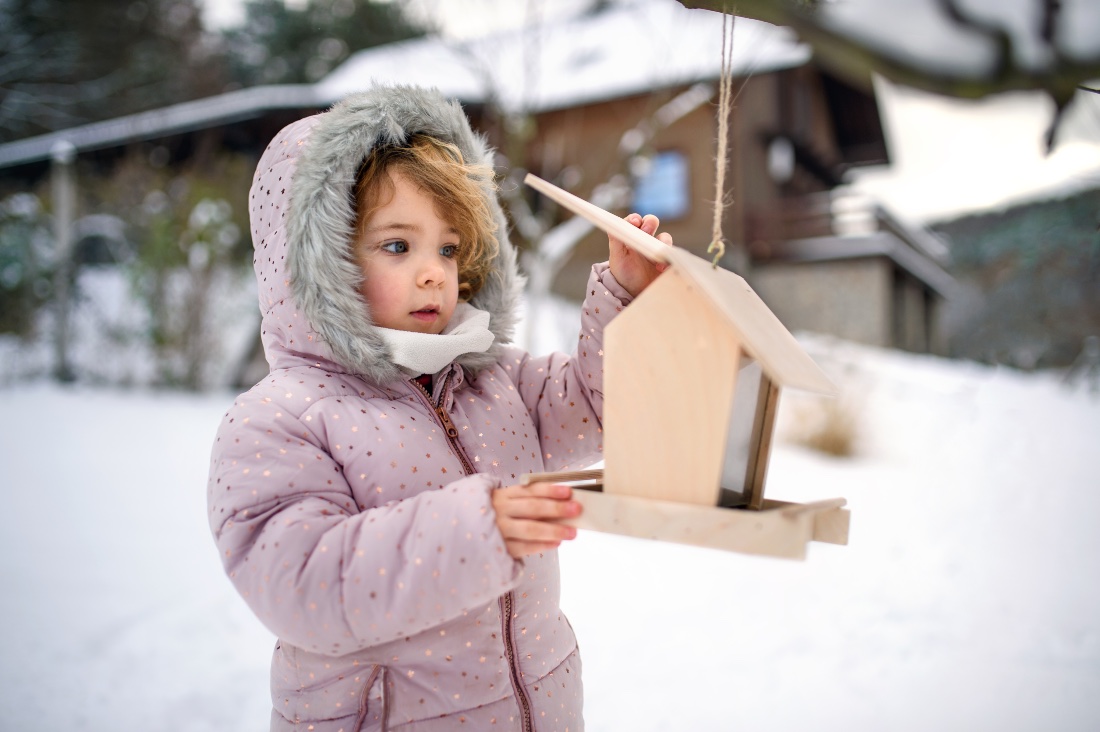Sustainable Orillia’s most dedicated ‘birder,’ Mike Jones, shares more ideas on how to create a bird-friendly garden, part of our ongoing series in support of Orillia becoming a ‘Bird Friendly City.’
_______________________________________
Apart from a recent dusting of snow and a few nights of temperatures one or two degrees below zero, at the time of writing Orillia seems to have escaped any seasonal bad weather. Perhaps this is why the Fall migration has been somewhat lacklustre to date, with small numbers of juncos, American goldfinches and grackles passing through. No flocks of redpolls, waxwings or varieties of sparrows to be had so far. Still, there are tasks to be done to prepare for both the winter and the birds to come.
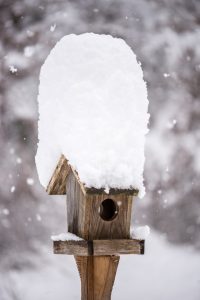
It’s time to take down and clean the nectar feeders as the hummingbirdsand northern orioles are long gone. For those of you who believe in tough love and do not feed the birds except during winter months, it’s now time to fill and put feeders up.
In a perfect world, birds should not need to be pampered as they are expert foragers and have existed perfectly well without human assistance. In fact, they have existed despite human persecution. To this day, in many countries around the world, many small birds we see in our gardens are hunted and slaughtered for food. (Four and twenty blackbirds baked into a pie, anyone?)
Our own local Christmas bird count was once not a count at all, but a Christmas bird kill, with every kind of bird spotted shot without mercy—and the person bringing in the most dead birds being the winner of the contest. To atone for our past misdeeds, it is not a bad thing to feed garden birds all year round which makes our gardens more bird-friendly and also gives us the pleasure of seeing them close up each day.
Migration is not only stressful, it is also tiring and a great expenditure of energy, so it is important to fill your feeders with the correct bird seed from a reputable supplier. Unfortunately, some mixtures on the market are of low quality, and not fit for the purpose. Shelled peanuts, black sunflower, and Niger seeds (also now called “Nyjer” by seed companies who don’t appear to see the need to note the seeds’ origins) are all nutritious, high in Omega 3 oil (about 30% to 40%) and very acceptable for most birds. Niger seeds, however, are very susceptible to mould, especially in the summer months; the mouldy seeds can clog the feeder and will be shunned by all birds. This time of year, this is not a problem, as a migrating flock of, say, redpolls can empty a Niger feeder in a few hours! In summer, however, if Niger is used, it should be provided in small quantities at a time, mixed with other seeds.
Another seed that is becoming more popular is safflower, which is white in colour and high in protein, fat and fibre. Safflower seed in some mixtures is sold as a cardinal blend, or sometimes as a mix that is unattractive to squirrels. There is some justification for this, as the seed has a bitter taste that is shunned, not only by squirrels, but also by the bullies of the feeder—grackles, starlings and blackbirds. Safflower is native to hot, arid countries where it is used for cooking oil or for vegetable dyes, although a growing amount is finding its way into high-end bird food. It can be grown in Orillia as a decorative annual, along with sunflowers, as both provide natural fodder for foraging birds. Chickadees and nuthatches especially like the seeds from both plants.
Soon migration will cease and our gardens will be left to the hardy souls that stay to brave the Canadian winter. Birds such as black-capped 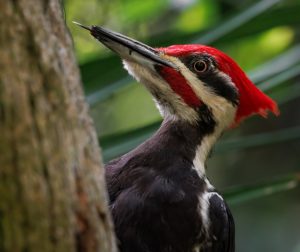 chickadees, white-breasted nuthatches, smaller and less common red-breasted nuthatches, cardinals, and most of the woodpeckers (downy, hairy, pileated, and red-bellied) will hang around your garden if you keep your feeders stocked up.
chickadees, white-breasted nuthatches, smaller and less common red-breasted nuthatches, cardinals, and most of the woodpeckers (downy, hairy, pileated, and red-bellied) will hang around your garden if you keep your feeders stocked up.
Some people, migratory sun-birds themselves, are afraid to put out feeders, believing that, in their absence, birds will become dependent on this artificial food supply and starve as a result of its disappearance. This is not the case. Our birds are much more resilient than that. Once a bird feeder is empty, all that will happen is that they will fan out and find other sources of nourishment, as do virtually all winter resident birds who do not frequent garden feeders. Cedar waxwings are here all winter, moving around in flocks to wherever there are berries. The white-winged crossbills seek wood lots where there are coniferous seeds to be had. This is yet another good reason to plant conifers and berry producers such as mountain ash and viburnum in your bird-friendly garden.
You will also find action away from the feeders. Chickadees, nuthatches, and brown creepers are constantly checking any crevice that might shelter hibernating insects or spiders. Chickadees go up or down trees with rough bark; nuthatches (the upside-down birds) always go down head first; brown creepers, always upwards. Downy, three-toed, and the rare (in Orillia) black-backed woodpecker will swipe their bills sideways to pry off flakes of pine bark to expose insects. This is another good reason not to waste money spraying for spiders and insects in your garden. It is ineffective, a waste of money—and destroys, not only the targeted species, but also the beneficial ones, including the ones that are a valuable winter food source for the birds you wish to attract.
Other sources of winter nourishment, apart from feeders, are the caches of nuts, acorns and seeds that birds such as chickadees and blue jays secrete away in many locations often over a large area. How on earth does a bird remember where they were all located? We now know that in early Fall a chickadee will actually add brain cells to a part of the brain, the hippocampus, that supports spatial memory. This is how it remembers the many locations of the stashes. The additional cells dissipate in the Spring when food becomes plentiful, just before the mating season—which I find amazing. (My partner, however, is not overly impressed, saying she has known of many humans, especially males, whose brain functions are also totally diminished during times of mating!)
Just because there are natural food sources in winter does not mean that feeders are not necessary. A small bird will expend a lot of caloric energy merely keeping warm enough to live through the frigid depth of a winter’s long night, so a quickly available food source in the morning can be a life saver.
For winter birds, suitable roosting places are at a premium. Deciduous trees, lacking leaves, are not a good option, giving little or no protection from the elements and none from nocturnal predators such as owls.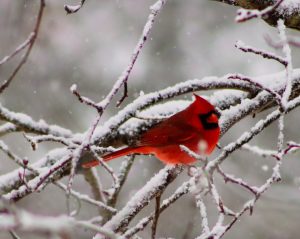 Cedar hedges and coniferous trees are a roosting godsend to cardinals, jays, plus every non-cavity-nesting bird, so are a must in a bird-friendly garden. Cavity nesters, if they can find a suitable cavity not pre-empted by squirrels, will huddle together for mutual warmth, so do not be surprised if your nesting boxes host several species at once, such as chickadees and nuthatches. To provide an added degree of insulation, do not remove old nesting material, despite the conventional wisdom that boxes should be cleaned out in the Fall to “deter pathogens and parasites.” Natural cavities have nests built on top of each other year after year without having, or requiring, the services of a removal and cleaning service, so why should your boxes be any different? If you must clean, wait until Spring.
Cedar hedges and coniferous trees are a roosting godsend to cardinals, jays, plus every non-cavity-nesting bird, so are a must in a bird-friendly garden. Cavity nesters, if they can find a suitable cavity not pre-empted by squirrels, will huddle together for mutual warmth, so do not be surprised if your nesting boxes host several species at once, such as chickadees and nuthatches. To provide an added degree of insulation, do not remove old nesting material, despite the conventional wisdom that boxes should be cleaned out in the Fall to “deter pathogens and parasites.” Natural cavities have nests built on top of each other year after year without having, or requiring, the services of a removal and cleaning service, so why should your boxes be any different? If you must clean, wait until Spring.
Over the winter, as you sit by your window watching the action around your feeders, you might ruminate on what a loss it would be if there were no more birds. How drab, how silent and how uninteresting the world would be! How terrible it would be if their extinction was the result of human activity.
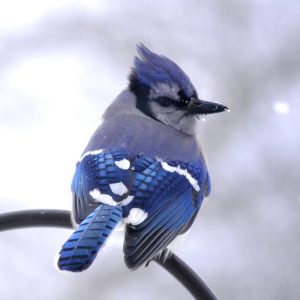 How even more terrible it would be if we sat around passively and made no effort to prevent their disappearance. A bird-friendly garden might be a small step in the right direction, but it is an important one.
How even more terrible it would be if we sat around passively and made no effort to prevent their disappearance. A bird-friendly garden might be a small step in the right direction, but it is an important one.

